| Lonicera involucrata | |
|---|---|
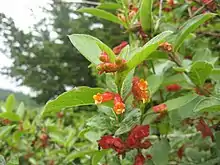 | |
| Lonicera involucrata var. ledebourii | |
| Scientific classification | |
| Kingdom: | Plantae |
| Clade: | Tracheophytes |
| Clade: | Angiosperms |
| Clade: | Eudicots |
| Clade: | Asterids |
| Order: | Dipsacales |
| Family: | Caprifoliaceae |
| Genus: | Lonicera |
| Species: | L. involucrata |
| Binomial name | |
| Lonicera involucrata | |
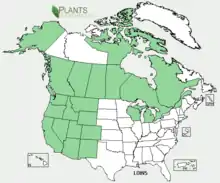 | |
| Distribution | |
| Synonyms[2] | |
| |
Lonicera involucrata, the bearberry honeysuckle, bracted honeysuckle, twinberry honeysuckle, Californian Honeysuckle,[3] twin-berry, or black twinberry, is a species of honeysuckle native to northern and western North America.
Distribution and habitat
It is found from southern Alaska east across boreal Canada to Quebec, and south through the western United States to California, and to Chihuahua in northwestern Mexico. It grows at elevations from sea level to 2,900 m.[4][5][6] While its conservation status is considered to be secure through most of its range, black twinberry is considered vulnerable in Alaska, Manitoba, and Colorado and critically imperiled in Wisconsin.[1]
It grows in moist, wooded areas, especially in clearings and on the edges of wetlands. Its Wetland Indicator Status is FAC+, so it is equally likely to be found in wetlands and non-wetlands.
Description
It is a large shrub that can grow 0.5–5 m high, with shoots with a quadrangular cross-section.
The leaves are elliptic to oval-shaped, 3–16 cm long and 2–8 cm broad; they are hairy along the margins and on the underside, and have a distinctive abruptly acuminate tip. They are of opposite arrangement.
The flowers are yellow, tubular, hairy, 1–2 cm long, and are monoecious; they are produced in pairs subtended by a pair of reddish basal bracts 2–4 cm across.
The fruit is a 6–12 mm diameter black berry containing several small seeds,[5][6][7] ripening in mid-to-late summer.[8]
Varieties
There are two varieties:[6][9][10]
- Lonicera involucrata var. involucrata. Most of the species' range, except as below; in California only in the Sierra Nevada. Leaves thin; flowers yellow.
- Lonicera involucrata var. ledebourii (Eschsch.) Jeps. Coastal California and southern Oregon. Leaves thick, leathery; flowers tinged orange to red outside.
Cultivation and uses
Use by humans
It is often used as an ornamental plant. It is resistant to air pollution, and can be kept in a large garden.[11] The berries may be edible or very unpalatable, or even poisonous[12]- Pacific Northwest Coast indigenous groups referred to them as 'monster food' and 'crow berry' for this reason.[13] [14]
It is commonly used in restoration applications throughout its native range, especially in riparian zones for stream bank stabilization.[15]
Native American groups such as the Quileute, Kwakwaka’wakw, and Haida made use of the plant in various ways. The berries were used to make black pigment and hair dye, and the bark, berries and leaves were made into poultices and teas.[15] The bark was used along with willow bark to weave clothing.[14]
Use by animals
The berries are eaten by bears, birds, and small mammals, and the flowers are an important source of nectar for hummingbirds, butterflies, and moths.[15] The twigs and leaves are browsed by deer.[14] However, in some parts of its range the plants are not abundant enough to be a staple food for wildlife.[16]
Images
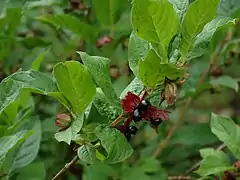 In fruit
In fruit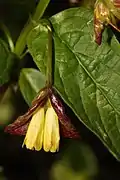 Variety involucrata
Variety involucrata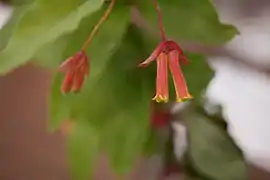 Twinberry
Twinberry
References
- 1 2 NatureServe (2024). "Lonicera involucrata". Arlington, Virginia. Retrieved 12 January 2024.
- ↑ "The Plant List: A Working List of All Plant Species". Retrieved 7 December 2014.
- ↑ BSBI List 2007 (xls). Botanical Society of Britain and Ireland. Archived from the original (xls) on 2015-06-26. Retrieved 2014-10-17.
- ↑ "Lonicera involucrata". Germplasm Resources Information Network. Agricultural Research Service, United States Department of Agriculture. Retrieved 8 January 2018.
- 1 2 Plants of British Columbia: Lonicera involucrata
- 1 2 3 Jepson Flora: Lonicera involucrata
- ↑ BorealForest: Lonicera involucrata
- ↑ Reiner, Ralph E. (1969). Introducing the Flowering Beauty of Glacier National Park and the Majestic High Rockies. Glacier Park, Inc. p. 58.
- ↑ Jepson Flora: Lonicera involucrata var. involucrata
- ↑ Jepson Flora: Lonicera involucrata var. ledebourii
- ↑ Blanchan, N. (2005). Wild Flowers Worth Knowing. Project Gutenberg Literary Archive Foundation.
- ↑ Darris, D. (2011). "Plant fact sheet for twinberry honeysuckle (Lonicera involucrata)" (PDF). USDA Natural Resources Conservation Service, Corvallis, OR.
- ↑ Schofield, Wilfred B.; Pojar, Jim; MacKinnon, Andy (1999). "Plants of the Pacific Northwest Coast". The Bryologist. 102 (4): 775. doi:10.2307/3244266. ISSN 0007-2745. JSTOR 3244266.
- 1 2 3 "Lonicera involucrata - black twinberry, bearberry honeysuckle". web.pdx.edu. Retrieved 2021-05-06.
- 1 2 3 "Black Twinberry - The North Creek Wetland - UW Bothell". www.uwb.edu. Retrieved 2021-05-06.
- ↑ Whitney, Stephen (1985). Western Forests (The Audubon Society Nature Guides). New York: Knopf. p. 427. ISBN 0-394-73127-1.
External links
![]() Media related to Lonicera involucrata at Wikimedia Commons
Media related to Lonicera involucrata at Wikimedia Commons
